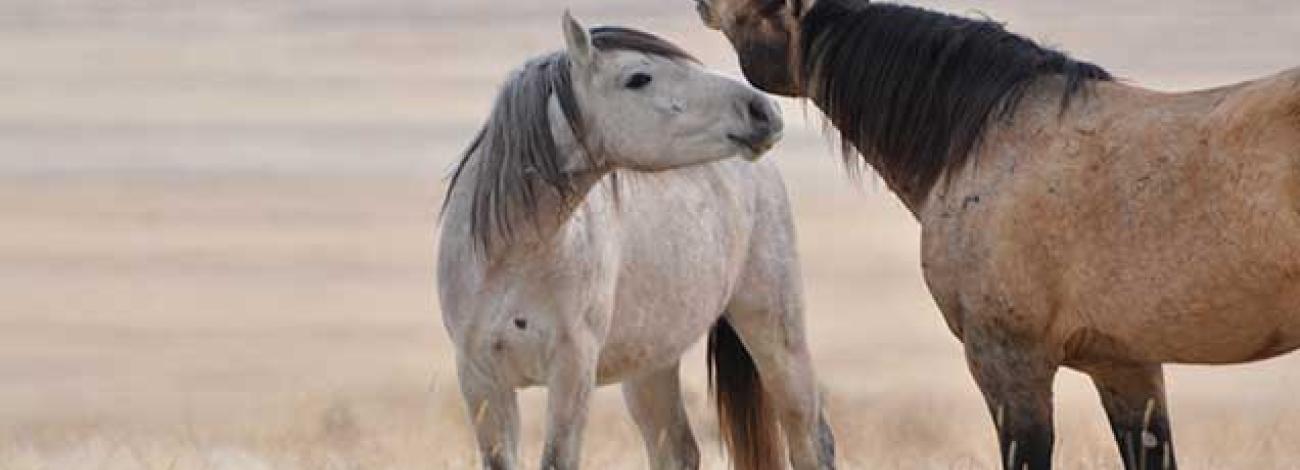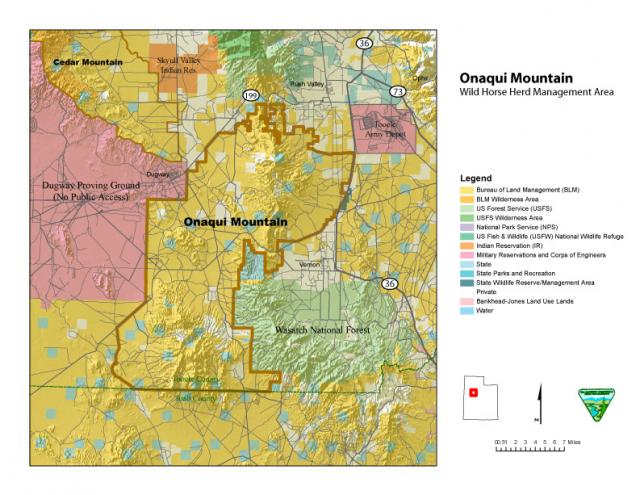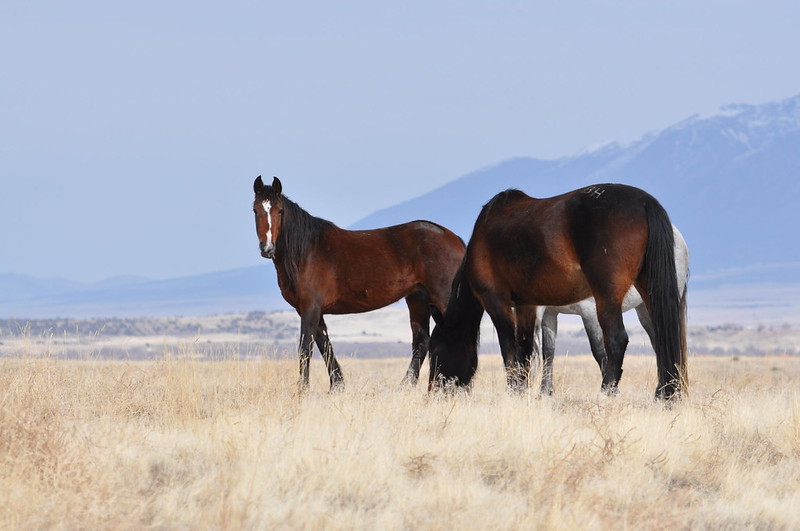
Onaqui Mountain HMA
Early settlers and the cavalry brought wild horses to the area in the late 1800s. Wild horses are usually gregarious and have few natural predators other than the occasional to mountain lions. Mares and stallions within the Onaqui Mountain Herd Management Area (HMA) have a slight to moderate build and average around 800 to 1000 pounds. The dominant colors within the herd area are brown and bay. In the early 1990s, BLM introduced wild horses from the Rock Springs, Wyoming area which increased the colors to include: sorrel, roan, buckskin, black, palomino, and gray. Currently, pintos, grays, palominos, and roans have begun to increase in numbers.
After a BLM gather in 2005, the herd was augmented with approximately 10 stallions and 10-15 mares from other HMAs of various origins. This was done to help with genetic diversity, to increase size of the individuals and adoptability of the Onaqui Mountain HMA wild horses. Every 3-4 years since then, another 3-5 horses have been released. These horses came from HMAs in Utah, Idaho, California, and Nevada.
Recent gathers that have occurred within the Onaqui Mountain HMA.
- 2009 – 218 horses gathered; 186 removed; 17 mares treated with PZP; 32 returned to the range.
- 2012 – 155 horses gathered; 34 removed; 57 mares treated with PZP; 120 returned to the range.
- In 2019 a total of 241 horses were gathered and removed from outside of the HMA.
- In 2021, a total of 435 horses were gathered. Of those 435 horses, 123 were returned to the range.
Since 2005, the Salt Lake Field Office has been applying fertility control vaccinations to mares in the HMA.
- 2005 – 56 mares treated with PZP-22
- 2009 – 17 mares treated with PZP-22
- 2012 – 57 mares treated with PZP-22
- 2015 – 12 mares treated.
- Spring 2016 – 45 mares treated.
- Fall 2016 – 5 mares treated.
- Spring 2017 – 48 mares treated.
- 2018 – 60 mares treated.
- 2019 – 86 mares treated.
- 2020 – 100+ mares treated.
Location
The Onaqui Mountain Herd Management Area (HMA) is located 60 miles southwest of Salt Lake City and extends from Johnsons Pass south to Look Out Pass.
Size
The HMA contains 206,878 acres of BLM lands and 33,275 acres of Federal, State, and privately-owned land for a total of 240,153 acres.
Topography/Vegetation
This HMA varies in elevation from 4,250 feet in elevation at the valley floor in Skull Valley, to 7,500 feet and 8,200 feet at the highest points in the Onaqui mountain range. Vegetation varies from the salt desert shrub and sagebrush types, to grass-juniper and juniper/barren ground type at the higher elevations. The vegetation on the upper elevations of the Onaqui Mountains is comprised of brush and scattered stands of conifers. The foothills area is vegetated by stands of juniper trees. The valley areas are covered with sagebrush and annual cheatgrass.
Stock reservoirs and intermittent streams fed by winter snows and spring runoff provide adequate water for the herd. As is consistent throughout desert regions, water is a limiting factor for many wildlife populations. To reduce the effects of the limited amount of water, water-collecting developments known as “guzzlers” have been constructed. These guzzlers, however, do not wholly support any or all wildlife populations within the area. Wildlife must still rely upon natural and human-created sources of water within the area that are shared by wild horses and livestock.
Wildlife
The HMA represents year-round habitat for mule deer and pronghorn. The eastern most portions of the Onaqui Mountain HMA encompass Sage grouse brooding and winter habitat. The Bald Eagle, Western Yellow-billed Cuckoo, and Ute Ladies tresses occasionally call the HMA home. A few of the nesting species in the area include Ferruginous Hawk, Swainsons Hawk, Red-tailed Hawk, Prairie Falcon, Golden Eagle, and Great-Horned Owl. Various non-game species including but not limited to kangaroo rats, coyotes, red fox, snakes, lizards, and toads also inhabit the area.
Appropriate Management Level (AML)
The Appropriate Management Level for this Herd Management Area ranges from 121-210.
Viewing Opportunities
There are several routes into the HMA. One recommended route is to take I-80 west from Salt Lake City to Exit 77 (U-196, Iosepa/Dugway). Turn left at the stop sign and continue south along UT-196 to the Dugway Proving Grounds main gate. Access the dirt road that runs south, immediately west of the church. Continue south to Pony Express Road, then head west towards Simpson Springs. Please note: Many of the Onaqui wild horse are habituated to close human presence. Please do not approach closer than 100 feet of any wild horse and never attempt to pet or feed any horses. The special character of wild horses can be changed by too frequent and close contact with humans. Please – help us to keep them wild!
Special Travel Conditions
Road conditions can be dusty, but usually easily traveled. Inclement weather can cause some of the roads to be impassable. It’s important to stay on existing roads and trails.


